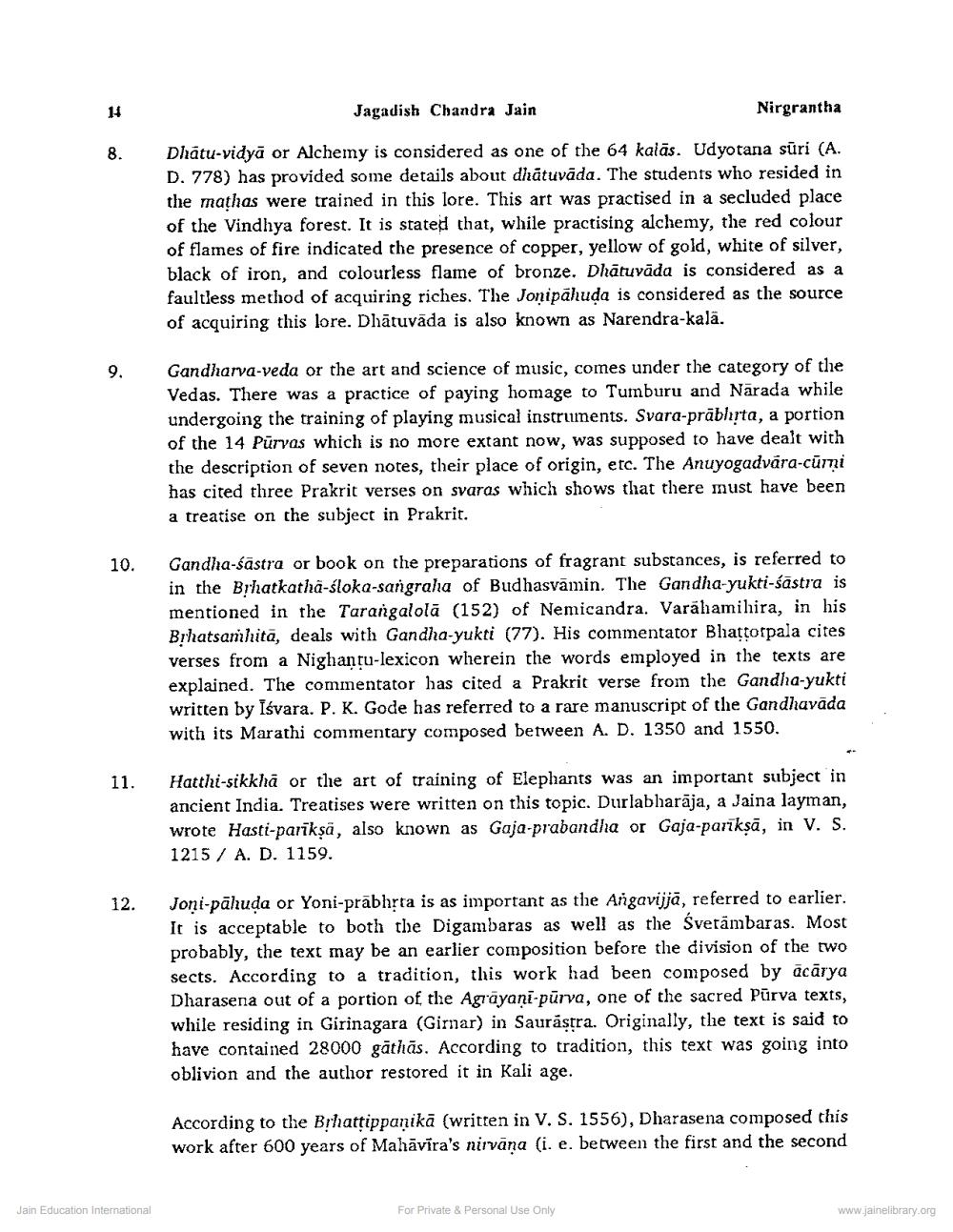________________
14
8.
9.
10.
11.
12.
Jain Education International
Jagadish Chandra Jain
Nirgrantha
Dhatu-vidya or Alchemy is considered as one of the 64 kalas. Udyotana süri (A. D. 778) has provided some details about dhātuvāda. The students who resided in the mathas were trained in this lore. This art was practised in a secluded place of the Vindhya forest. It is stated that, while practising alchemy, the red colour of flames of fire indicated the presence of copper, yellow of gold, white of silver, black of iron, and colourless flame of bronze. Dhatuvada is considered as a faultless method of acquiring riches. The Jonipähuda is considered as the source of acquiring this lore. Dhatuvada is also known as Narendra-kalä.
Gandharva-veda or the art and science of music, comes under the category of the Vedas. There was a practice of paying homage to Tumburu and Narada while undergoing the training of playing musical instruments. Svara-präblirta, a portion of the 14 Purvas which is no more extant now, was supposed to have dealt with the description of seven notes, their place of origin, etc. The Anuyogadvära-cürni has cited three Prakrit verses on svaras which shows that there must have been a treatise on the subject in Prakrit.
Gandha-sastra or book on the preparations of fragrant substances, is referred to in the Byhatkatha-sloka-sangraha of Budhasvamin. The Gandha-yukti-Sastra is mentioned in the Tarangalola (152) of Nemicandra. Varáhamihira, in his Brhatsamhita, deals with Gandha-yukti (77). His commentator Bhattotpala cites verses from a Nighantu-lexicon wherein the words employed in the texts are explained. The commentator has cited a Prakrit verse from the Gandha-yukti written by Isvara. P. K. Gode has referred to a rare manuscript of the Gandhavada with its Marathi commentary composed between A. D. 1350 and 1550.
Hatthi-sikkha or the art of training of Elephants was an important subject in ancient India. Treatises were written on this topic. Durlabharaja, a Jaina layman, wrote Hasti-parikşü, also known as Gaja-prabandha or Gaja-pariksa, in V. S. 1215/A. D. 1159.
Joni-pähuda or Yoni-prabhṛta is as important as the Angavijjä, referred to earlier. It is acceptable to both the Digambaras as well as the Svetämbaras. Most probably, the text may be an earlier composition before the division of the two sects. According to a tradition, this work had been composed by ācārya Dharasena out of a portion of the Agrāyaṇi pūrva, one of the sacred Purva texts, while residing in Girinagara (Girnar) in Saurastra. Originally, the text is said to have contained 28000 gāthās. According to tradition, this text was going into oblivion and the author restored it in Kali age.
According to the Bhattippanikä (written in V. S. 1556), Dharasena composed this work after 600 years of Mahavira's nirvana (i. e. between the first and the second
For Private & Personal Use Only
www.jainelibrary.org




